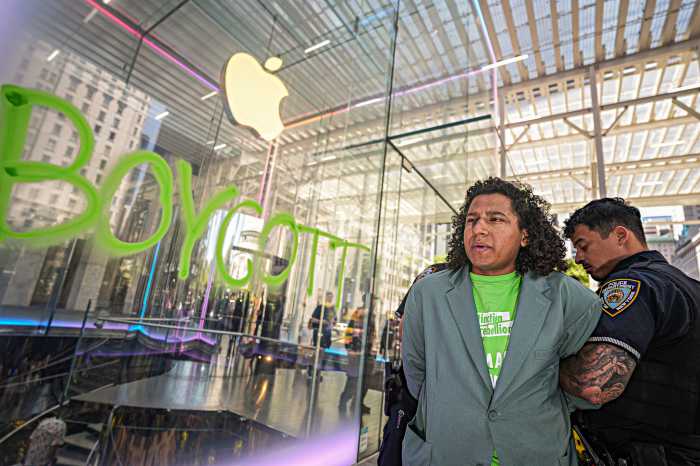Restored Seven Months After Sandy
It won’t be back in time for the Memorial Day weekend, but service on the A train to and from the Rockaways-suspended since October due to damage caused by Hurricane Sandy- will be restored on Thursday, May 30, the MTA and Gov. Andrew Cuomo announced last week.

When Hurricane Sandy blasted the New York City area on Oct. 29, 2012, the storm surge she created washed out more than 1,500 feet of track carrying the A line across Jamaica Bay between Howard Beach and the Rockaways. Flooding also damaged the Broad Channel and Rockaway Park stations served by both the A line and the Rockaway Park Shuttle, which was also knocked out of service by the storm.
Beginning next Thursday, trains will once again roll on the A line south of Howard Beach, running their previously scheduled routes between Rockaway Park and Far Rockaway. The Rockaway Park Shuttle will also be restored, bringing the subway network in Queens back to where it was prior to Sandy.
Cuomo noted that MTA workers have undertaken “an all-out, sixmonth” effort to not only repair the damage Sandy incurred on subway lines south of Howard Beach but also fortify the train system to prevent future storms from causing similar damage.
Those using the A train traveling to and from the Rockaways will notice that the MTA has installed a marine steel sheet wall along the two-mile stretch of track running across Jamaica Bay. This wall intends to prevent “future washouts and ensure the line is ready to handle future coastal storms,” as noted in the joint press release issued by the governor and the MTA.
“Superstorm Sandy devastated the entire MTA network like no other storm, but the MTA did a remarkable job of restoring service following the storm, and at the end of this month, the A line in the Rockaways will be up and running,” Cuomo said last Thursday. “The last six months have meant substantial cleanup and repair, leading to the rapid restoration of full service in all but the hardest-hit facilities. Now we must focus on the priority and challenge of making permanent repairs to keep the subways safe and reliable for years to come because the people and businesses of New York depend on a strong and robust mass transit system.”
Repairing damage to the Rockaway Line caused by Sandy was a herculean effort for the authority, according to MTA Interim Executive Director-and MTA Chairman and CEO-designate-Thomas F. Prendergast. Along with removing thousands of tons of debris from the tracks, crews had to rebuild the line almost from scratch, replacing miles of tracks, cables and electrical lines and essential equipment needed to operate subway trains.
“The work that went restoring service to the Rockaways was impressive when you balance the amount of work that had to be done with the relatively short time it took to perform it,” Prendergast stated in an article on www.mta.info regarding the restoration subway service to the Rockaways. “The Rockaway Line has been in service since 1956 and the recently completed work was nearly as difficult an endeavor as building the railroad from the ground up.”
Over the last six months, traveling to and from the Rockaways without a car was difficult. Without a direct rail link with the rest of the city, travelers were forced to transfer from the A train at Howard Beach to a shuttle bus stopping at Far Rockaway Mott Avenue.
Additional buses were added to local and limited bus routes stopping in the Rockaways. The MTA also introduced a free, temporary H train shuttle running exclusively across the peninsula between Far Rockaway and Beach 90th Street. To establish this line, train cars were trucked into the Rockaways and placed onto tracks with cranes.
The H train will be ended once the A train and Rockaway Park Shuttle are brought back online next Thursday.
In all, the MTA suffered an estimated $4.755 billion in damage to its subway and commuter rail infrastructure, as well as to the bridges and tunnels it operates. Eight subway tunnels below the East River and Newtown Creek were flooded with sea water during Sandy, as were a number of subway yards and stations in coastal and low-lying areas of the city .
Within a few weeks, much of the subway network was back up and running through around-the-clock efforts by MTA crews to pump out water from the flooded tunnels and make temporary repairs to restore service. The authority noted, however, it will take several years to make permanent repairs not only fixing what Sandy damaged but also fortifying the system to prevent a similar scenario when another major hurricane or coastal storm strikes the city .
To that end, the MTA launched its “Sandy Recovery and Resiliency Division,” a bureau aimed at managing the post-Sandy rebuilding process and implementing ways to protect critical infrastructure. The division’s goal, it was noted, is to protect all points where the subway system could be flooded.
Reportedly, the MTA has issued six task orders to six architectural and engineering firms to design system repairs, study ways to flood-proof the city’s subway system and develop schematics for devices and methods to protect the train network.
“We are using all means available to jump-start this effort, so we can not only restore our system to the condition it was before Sandy struck, but harden it against similar storms that we expect to arrive in the future,” Prendergast said in the press release announcing the restoration of A train and Rockaway Park Shuttle service.
For more information, visit www.mta.info.
































